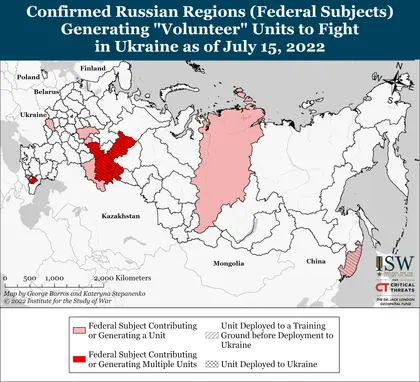Key Takeaways
- The Russian Ministry of Defense’s meeting with the leadership of the Eastern grouping of forces in Ukraine suggests that the Kremlin will not focus on seizing Slovyansk at this stage of the campaign but will instead prioritize attempting to seize Siversk and Bakhmut.
- Russian President Vladimir Putin’s likely effort to put the burden of supporting operations in Ukraine on ethnic minorities to avoid conducting a general mobilization of ethnic Russians may be sparking resistance in ethnic enclaves in Russia.
- Russian forces conducted a series of ground attacks east of Siversk and south of Bakhmut.
- Russian forces intensified efforts to advance on Avdiivka and conducted limited ground assaults along the Donetsk City-Avdiivka frontline.
- Russian authorities are continuing to integrate occupied areas into the Russian trade economy.
Russian Defense Minister Sergey Shoigu’s July 18 meeting with the commander of the Eastern group of forces Lieutenant General Rustam Muradov supports ISW’s assessment that Moscow will not prioritize an attack to seize Slovyansk in this stage of the operation but will instead focus on seizing Siversk and Bakhmut.
JOIN US ON TELEGRAM
Follow our coverage of the war on the @Kyivpost_official.
The Russian Ministry of Defense (MoD) announced on July 18 that Shoigu inspected the Eastern group and directed Muradov to prioritize the destruction of Ukrainian long-range missiles and artillery systems. This is the first time ISW has observed explicit mention of the Eastern force grouping operating in Ukraine in this phase of the war. The Russian MoD previously reported that the Central and Southern force groups took part in the capture of Luhansk Oblast under the leadership of Colonel General Aleksandr Lapin and Army General Sergey Surovikin. The Eastern group of forces is likely comprised of elements of the Russian Eastern Military District (EMD), which have been active along the Izyum axis in Kharkiv Oblast. It is still unclear whether Muradov also directly controls operations around Kharkiv City. Muradov’s forces are operating in the Izyum-Slovyansk direction ostensibly with the objective of eventually seizing Slovyansk itself, and it is noteworthy that Shoigu did not direct Muradov to prioritize taking ground along this axis at this time. Muradov holds a lower rank than both Lapin and Surovikin, suggesting that the Kremlin considers the Izyum-Slovyansk area to be a lower priority than capturing territory in Donetsk Oblast as part of the wider Donbas campaign. The Kremlin likely is focusing military resources and high-rank leadership on localized and discrete gains around Siversk and Bakhmut, despite Shoigu’s earlier calls for the intensification of operations along all axes of advance.

EU Transfers €1.5 Bln Raised From Russian Assets for Ukraine
Russian President Vladimir Putin’s likely effort to shield ethnic Russians from high levels of mobilization may trigger resistance in some of the ethnic enclaves that seem to be disproportionately bearing the burden of war.
Russian Telegram channel Rybar released a report on July 18 about the Novaya Tuva movement- an anti-war organization comprised of activists from the Tuvan ethnic minority enclave. Rybar accused the Novaya Tuva movement of disseminating anti-war propaganda and inciting ethnic discord within the Russian Federation. This report is noteworthy in the context of the recent increase in the formation of regionally-based volunteer battalions through Russia, many of which fall along distinct ethnic lines. ISW and others have previously noted the prevalence of non-ethnic Russian battalions fighting in Ukraine, which include troops from Chechnya, South Ossetia, Tuva, Tartarstan, Bashkortostan, Chuvashia, and others. These indicators suggest that Putin may be unwilling to conduct general mobilization in part due to a reluctance to mobilize large numbers of ethnic Russians. Rybar’s post as well as previous reporting on a “Free Buryatia” anti-war group bring to the fore the risk that Putin’s apparent desire to have non-Russians bear the brunt of the war at this stage could create domestic tension in these regions.
Authors: Karolina Hird, George Barros, Layne Philipson, and Frederick W. Kagan.
Read the full report here.
You can also highlight the text and press Ctrl + Enter






